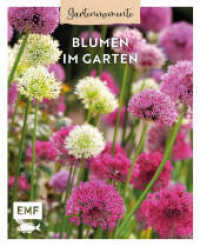- ホーム
- > 洋書
- > 英文書
- > Science / Mathematics
Full Description
The edited book highlights comprehensive studies on plant diversity dynamics, ecosystem processes, and best conservation practices from the interdisciplinary perspectives such as the botanists, ecologists, conservation biologists, geneticists, cell biologists, molecular biotechnologists, and social scientists. The main focus of the book is to address biodiversity loss and ecosystem collapse amidst the escalating climate change problems, aggravated by anthropogenic activities in biocultural landscapes. The book describes the biocultural landscape of today, ecology of plant diversity, botany of keystone and other rare species of economic and pharmaceutical significance, ecosystem processes, conservation, and emerging frameworks to sustain biocultural landscapes in the Anthropocene. Biocultural landscapes are tracks of land in many parts of the world, shaped by unique human-nature interactions. Many of these landscapes are populated with indigenous peoples with a unique way of life including their interaction with plants and the environment. The relationship between humans and nature in biocultural landscapes used to be harmonious. However, as the human population surges, much pressure has been experienced by the landscape, hence, the loss of biodiversity and degradation of ecosystem services that cascade to agricultural systems. The book is of interest to teachers, professors, policymakers, researchers, and advocates in the fields of botany, ecology, taxonomy, biodiversity conservation, environmental science, molecular biology and genomics, molecular ecology, agriculture, and Agri-tourism, forestry, social science, and climate change professionals. Also, the book serves as a good reference and additional reading material for undergraduate and graduate students.
Contents
Part 1. Biocultural Landscapes During the Anthropocene.- Chapter 1. Understanding Plant Diversity Dynamics in Biocultural Landscapes During The Anthropocene.- Chapter 2. Building Sustainability in Community-Managed Mangrove Forest using Biocultural Approach to Conservation.- Chapter 3. Plant Diversity in Biocultural landscapes during Anthropocene: The Need For Conservation, Challenges, and Future Prospects in Today's World.- Chapter 4. Extinction of Medicinal Plants in Anthropocene Epoch: Special Reference to Rauwolfia Serpentina.- Part 2. Keystone and Other Significant Species in Bicultural Landscapes.- Chapter 5. Ethnobotany of Yams (Dioscoreaceae) Used by Local Communities in the Northwest of Luzon Island.- Chapter 6. A Preliminary Survey of The Genus Hoya R.Br. (Apocynaceae) in Papua, Indonesia with Notes on Hoya as Larval Food plant of Euploea netscheri Snellen.- Chapter 7. Species Diversity and Habitat Association of Ferns and Lycophytes in Mts. Palay-Palay Mataas na Gulod Protected Landscape.- Chapter 8. Remaining Subpopulations of Impatiens Manillensis Walp. 1843 (Balsaminaceae) In Mts. Palay-Palay-Mataas-Na-Gulod Protected Landscape, Luzon Island, Philippines.- Chapter 9. Pteridophytes in Mount Matutum Protected Landscape.- Chapter 10. Morphological Diversity of Kopyor Coconut in Indonesia.- Chapter 11. Ecology of Understory Plants of Forests over Limestone in Samar Island, Philippines.- Chapter 12. Taxo-ethnobotany of Genus Ficus l. In Jammu and Kashmir State (India).- Part 3. Ecosystem Prcesses in Bicultural Landscapes.- Chapter 13. Food to Medicine: The Impact of Soil and Climatic Factors on the Phytochemical Property of Anahaw (Saribus rotundifolius (Lam.) Blume Shoot.- Chapter 14. Floral and Fruiting Phenology in the Lowland Forests of Palanan, Isabela, Philippines.- Chapter 15. A Survey of Understory Vegetation in the Biocultural Landscape of Mount Makiling, Luzon Island, Philippines: Implications for Sustainable Management.- Chapter 16. Floral Diversity and Carbon Stock Assessments of Montane Forests Along the Tri-Boundaries of Benguet, Ifugao and Mountain Province, Philippines.- Chapter 17. The Dynamics of Soil Microbiome Upon Anthropogenic Changes In Plant Diversity and Land Management Practices.- Chapter 18. Plants' anatomical and genetic responses to anthropogenic climate change and human-induced activities.- Chapter 19. Impact of Anthropogenic compounds on biodiversity: A comprehensive analysis.- Part 4. Best Practices in Plant Diversity Conservation.- Chapter 20. Documentation of the Phenocalendar of Allaeanthus luzonicus (Blanco) Fern.-Vill. (Family Moraceae) to Sustain Its Utilization .- Chapter 21. Analyzing the Spatio-Temporal Changes of the Biocultural Landscape of Banaue, Philippines Using GIS.- Chapter 22. Plant Diversity in Selected Agro- and Forest Ecosystems in Indigenous Cultural Communities (ICCs) in the Cordillera Region, Northern Philippines.- Chapter 23. The Stories of Organic Farming Champions in the Philippines and their Crop Diversity Practices.- Chapter 24. Current status of Seaweed diversity: Anthropogenic interventions.- Part 5. Emerging Frameworks for Conservation.- Chapter 25. Homegarden Agroforestry for Plant Diversity Conservation in an Urban Landscape: Practices and Prospects.- Chapter 26. Comprehending the cultural landscape of Mount Makiling: a road to Community Wellbeing necessary to enhance ecosystem integrity.- Chapter 27. System Dynamic Modelling of Top Harvested Plant Bioresources in Northern Negros Natural Park.- Chapter 28. Heritage Negotiations in Manila and Pampanga: The Use of Toponyms in the Study of Two Biocultural Landscapes in the Philippines.- Chapter 29. Liaforestry-sustainable Forest Management Model Using Multi-Purposes Tree Species for Reforestation and Climate Change Mitigation, Lesson Learned from Meru Betiri National Park.- Chapter 30. Conservation of IUCN Threatened Zingiberaceae Species in Tropical Asia:Challenges, Gaps and Opportunities.








